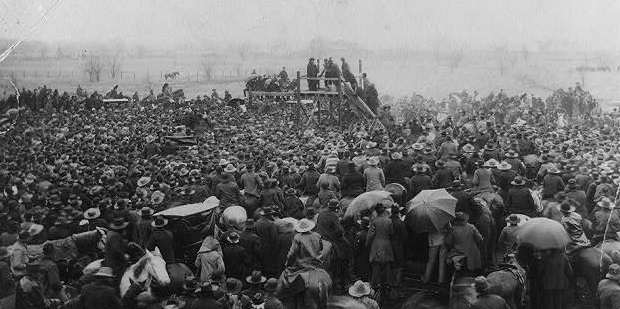On Friday, February 3, 1893, Henry Smith was lynched in Paris, Texas, in front of an estimated 15,000 spectators. His death was one of the earliest spectacle lynchings on record. The heinousness of Smith’s death captured the attention of journalist and anti-lynching advocate Ida B. Wells. She included a detailed description of the event in her seminal The Red Record, a work that sought to expose the iniquities of racialized mob violence.
Smith was implicated in the death of Myrtle Vance, a four-year-old white girl and daughter of Henry Vance, a Paris police officer. Her body was found in the woods near Paris on January 27. Considered inoffensive and feeble-minded by many Paris residents, Smith supported himself through odd jobs at the homes of local whites. Despite his seemingly harmless disposition, his encounters with the child’s father seemed to make him an easy target for suspicion. Henry Vance, a man known for his temper and mistreatment of prisoners, had arrested Smith and beaten him for disorderly conduct and drunkenness several days prior to Myrtle’s murder. Some local residents contended that the crime against Myrtle was exacted by Smith in revenge.
After discovering that he was named a suspect, Smith fled to Detroit, Michigan, then boarded a freight train and headed for his previous residence in Arkansas. Perhaps Smith believed he could find safe harbor in his former hometown. He was captured in Hope, Arkansas, more than one hundred miles from Paris. News of Smith’s impending return spread across portions of Arkansas and Texas. Citizens of Paris quickly announced the day and time that Smith would be tortured and burned as no trial was intended.
When the train carrying Smith back to Paris pulled into the station at Texarkana, 5,000 people awaited his arrival. He was placed atop a platform (described by some as being like a float in a parade) that carried him to a scaffold specially constructed near Paris with the moniker justice written across the front. Eventually 15,000 spectators gathered at the scaffold, with men, women and children, straining their necks and straddling other spectators to obtain an unobstructed view.
Relatives of Vance stood on the shoddy wooden platform besides Smith and began to cut his shirt, piece by piece, from his body and toss the pieces to the crowd as souvenirs. They then applied hot iron rods to his torso, plunging them down his throat and into his eyes. He was then doused in oil and set on fire. Smith screamed in agony. As he and the coals beneath him began to burn, Smith attempted to escape the platform and fell ten feet to the ground. He was lassoed and lifted back into the fire by members of the mob.
Appalled by the lynching, Texas Governor Stephen Hogg dispatched a telegram to the Sheriff of Lamar County the day following Smith’s burning, requesting that those responsible be arrested. Despite both the governors’ plea for justice and the public nature of the crime, no one was ever arrested for the torture and murder of Henry Smith.
Nearly two weeks following Smith’s death, a group of white men hanged William Butler, Smith’s stepson, in nearby Hickory Creek for allegedly concealing information regarding Smith’s location. Butler’s murderers were also never punished.

